Exploring Château de Chambord: A Journey Through Renaissance Splendor

Introduction
Château de Chambord, nestled in the heart of the Loire Valley, is a quintessential symbol of French Renaissance architecture and grandeur. This magnificent château, commissioned by King Francis I in the early 16th century, stands as a testament to the artistic and architectural innovations of its time. With its intricate design, sprawling gardens, and rich history, Château de Chambord is a marvel that attracts visitors from around the globe.
This château is not just a relic of the past but a living monument that encapsulates the essence of French royalty, culture, and architectural brilliance. From its stunning façade and iconic double-helix staircase to its beautifully landscaped gardens and panoramic rooftop views, every corner of Château de Chambord offers a glimpse into the opulence and grandeur of the Renaissance period.
In this article, we will embark on a detailed tour of Château de Chambord, exploring its exterior splendor, the famed grand staircase, the exquisite interior spaces, the breathtaking rooftop views, and the meticulously designed gardens. We will also provide practical information and tips for visitors to ensure a memorable and enriching experience at this iconic château.
The Exterior Splendor
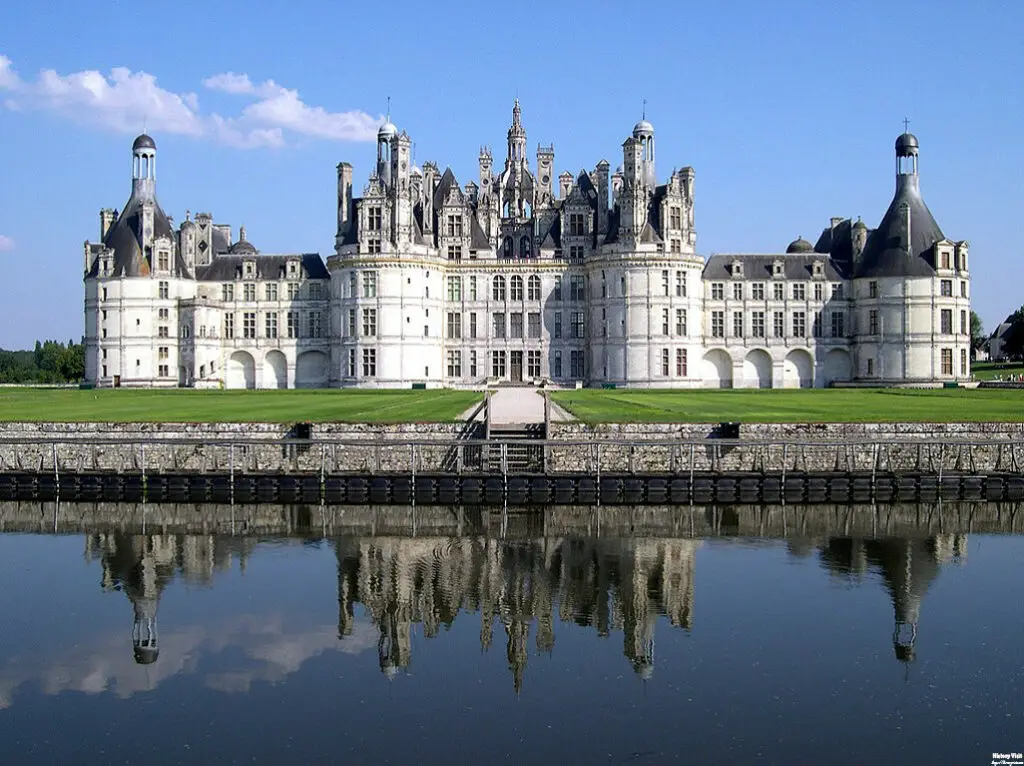
The exterior of Château de Chambord is a masterpiece of Renaissance architecture, blending traditional medieval forms with classical Italian structures. The château’s façade is adorned with a multitude of towers, chimneys, and dormer windows, creating a picturesque and somewhat fantastical silhouette against the Loire Valley landscape. This architectural complexity is a reflection of the château’s ambitious design and the artistic vision of King Francis I.
One of the most striking features of the exterior is the central keep, surrounded by four massive towers. The symmetry and balance of the design are enhanced by the elaborate stonework and the use of high-quality materials, which have stood the test of time. The château’s moat and extensive grounds further add to its medieval charm, while the detailed carvings and sculptures on the walls exhibit the finesse of Renaissance artistry.
The exterior also features the iconic double-helix staircase, visible through the central tower’s large windows. This architectural marvel draws attention to the ingenuity and creativity of the designers, believed to have been inspired by Leonardo da Vinci. The intricate interplay of light and shadow on the stone surfaces adds a dynamic element to the château’s façade, making it a captivating sight for visitors.
The Grand Staircase
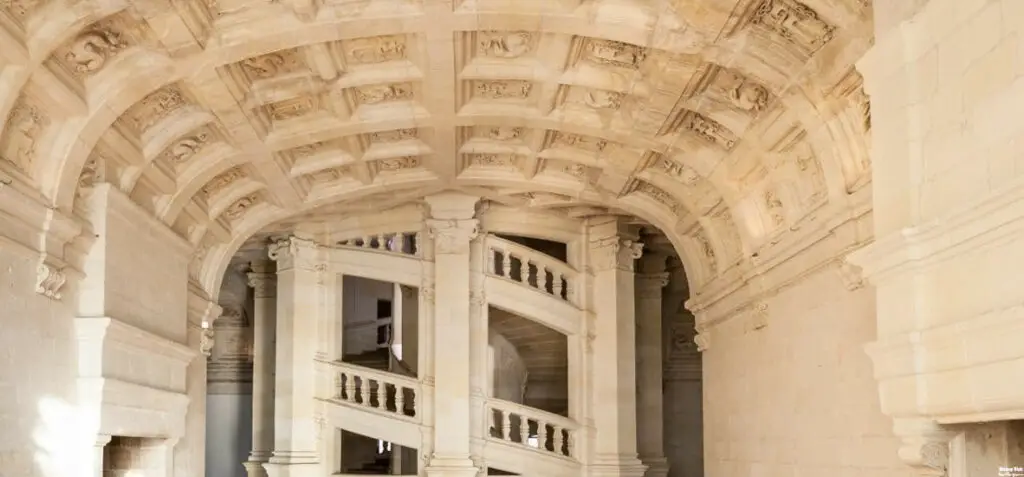
At the heart of Château de Chambord lies the grand double-helix staircase, one of the most famous and ingenious features of the château. This staircase consists of two intertwined spirals that allow individuals to ascend and descend without crossing paths. The design is often attributed to Leonardo da Vinci, who spent his final years in France and greatly influenced the architectural innovations of the period.
The staircase is a marvel of engineering and aesthetics, rising through the central keep and illuminated by a skylight at the top. Visitors ascending the stairs can look through the gaps in the stone balustrades to see those on the other spiral, creating a sense of connection and interaction while maintaining separation. This design not only highlights the château’s grandeur but also serves as a practical solution to the flow of movement within the building.
The grand staircase is surrounded by a central atrium, which is a focal point of the château’s interior. The stone carvings and decorative elements on the staircase reflect the Renaissance style, with intricate patterns and motifs that add to its beauty. Climbing the grand staircase is an experience in itself, offering visitors a unique perspective on the architectural brilliance and historical significance of Château de Chambord.
Rooms and Interior Spaces
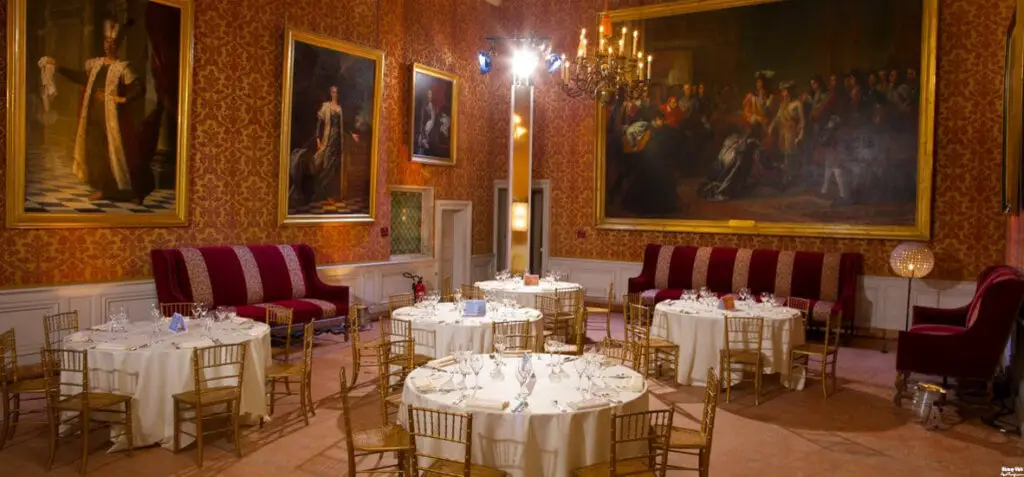
The interior of Château de Chambord is a testament to the opulence and grandeur of the French Renaissance. The château boasts over 400 rooms, each with its own unique charm and historical significance. The royal apartments, located in the central keep, are among the most luxurious spaces, featuring lavish furnishings, ornate tapestries, and intricate woodwork that reflect the tastes and styles of the period.
One of the highlights of the interior is the chapel, a beautifully designed space with high vaulted ceilings, stained glass windows, and exquisite altars. The chapel’s design showcases the blend of Gothic and Renaissance architectural elements, creating a serene and majestic atmosphere. This sacred space was used for royal ceremonies and private worship, adding to the spiritual and cultural significance of the château.
The grand salons and reception rooms are equally impressive, with their vast spaces, decorative ceilings, and rich artwork. These rooms were designed to host lavish gatherings and entertain guests, demonstrating the château’s role as a center of social and cultural life. Notable artworks and furnishings, including portraits of King Francis I and other historical figures, adorn the walls, providing visitors with a glimpse into the grandeur and elegance of the French court.
The Rooftop and Panoramic Views
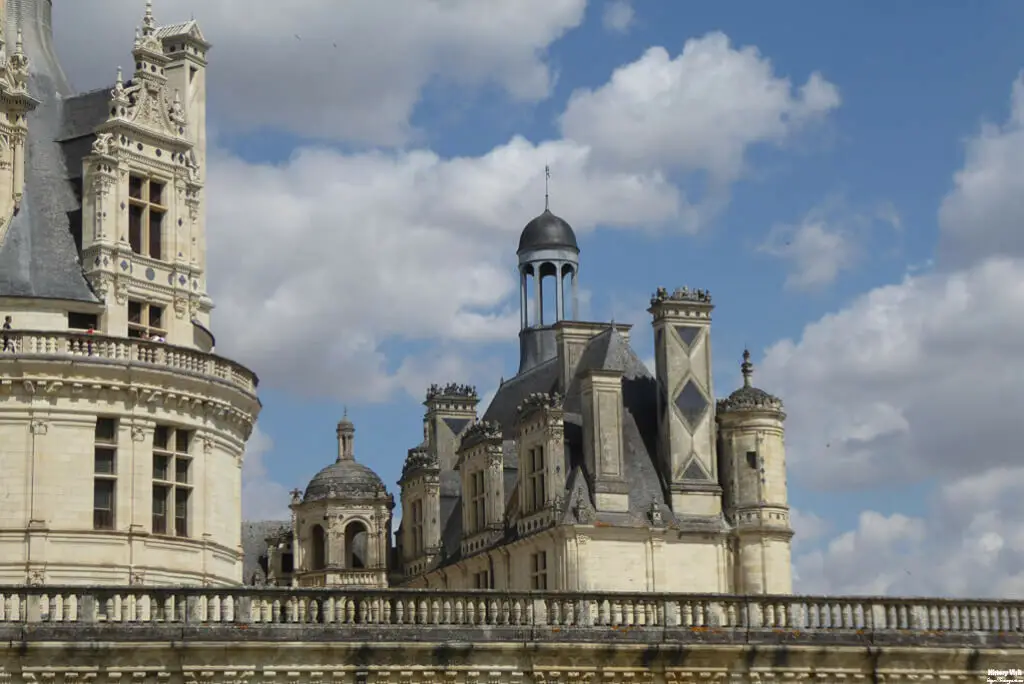
One of the most captivating features of Château de Chambord is its rooftop, which offers panoramic views of the surrounding Loire Valley. The rooftop terraces are accessible to visitors and provide a unique vantage point to appreciate the château’s architectural complexity and the beauty of its natural setting. From the rooftop, one can see the intricate patterns of the roof tiles, the numerous chimneys, and the central lantern tower that dominates the skyline.
The rooftop is designed with a series of walkways and terraces that allow visitors to explore different sections and enjoy the views from various angles. The balustrades and stone carvings on the rooftop reflect the same level of craftsmanship seen throughout the château, with detailed motifs and decorative elements that add to its charm. The rooftop also offers a closer look at the double-helix staircase, with its spirals extending upward and visible through the central atrium.
The panoramic views from the rooftop extend across the château’s gardens and the surrounding forest, providing a breathtaking perspective of the landscape. On a clear day, visitors can see for miles, taking in the beauty of the Loire Valley and the serene ambiance of the château’s setting. The rooftop experience is a highlight of any visit to Château de Chambord, offering a perfect blend of architectural wonder and natural beauty.
Gardens and Surrounding Grounds
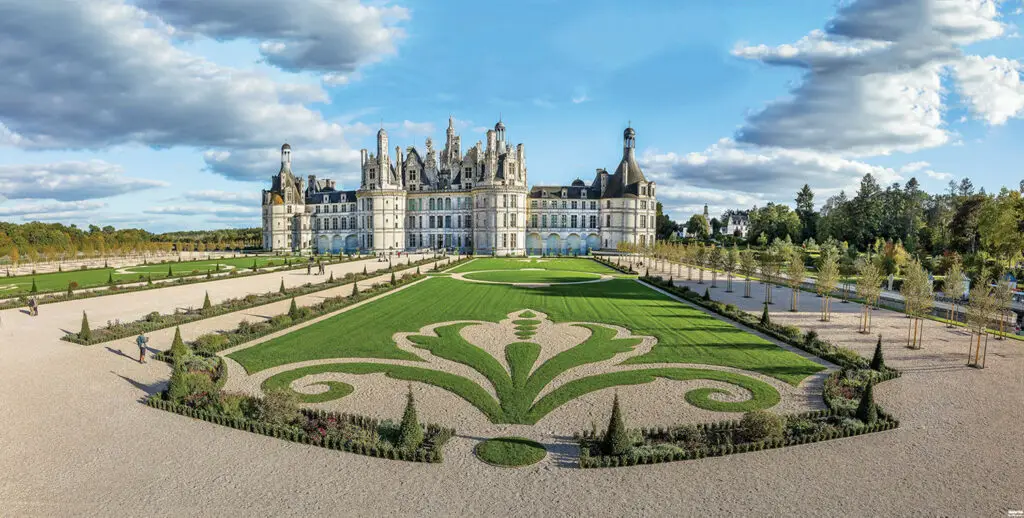
The gardens and surrounding grounds of Château de Chambord are an integral part of its grandeur and appeal. Designed to complement the architectural splendor of the château, the gardens are meticulously landscaped with a combination of formal French gardens and expansive parklands. The geometric patterns of the parterres, lined with manicured hedges and colorful flowerbeds, create a visual harmony that enhances the overall aesthetic of the estate.
The château’s hunting park, spanning over 13,000 acres, is one of the largest enclosed forested parks in Europe. This vast area was originally used by King Francis I and his successors for hunting, reflecting the royal pastime and the château’s connection to the natural landscape. Today, the park is a protected area, home to diverse wildlife and offering visitors the opportunity to explore its scenic beauty through walking and cycling trails.
The gardens also feature several water features, including reflective pools and fountains that add to the tranquil ambiance. The combination of water, greenery, and architectural elements creates a serene environment that invites visitors to relax and enjoy the beauty of the surroundings. Seasonal changes bring different colors and atmospheres to the gardens, making each visit to Château de Chambord a unique experience.
Visitor Information and Tips
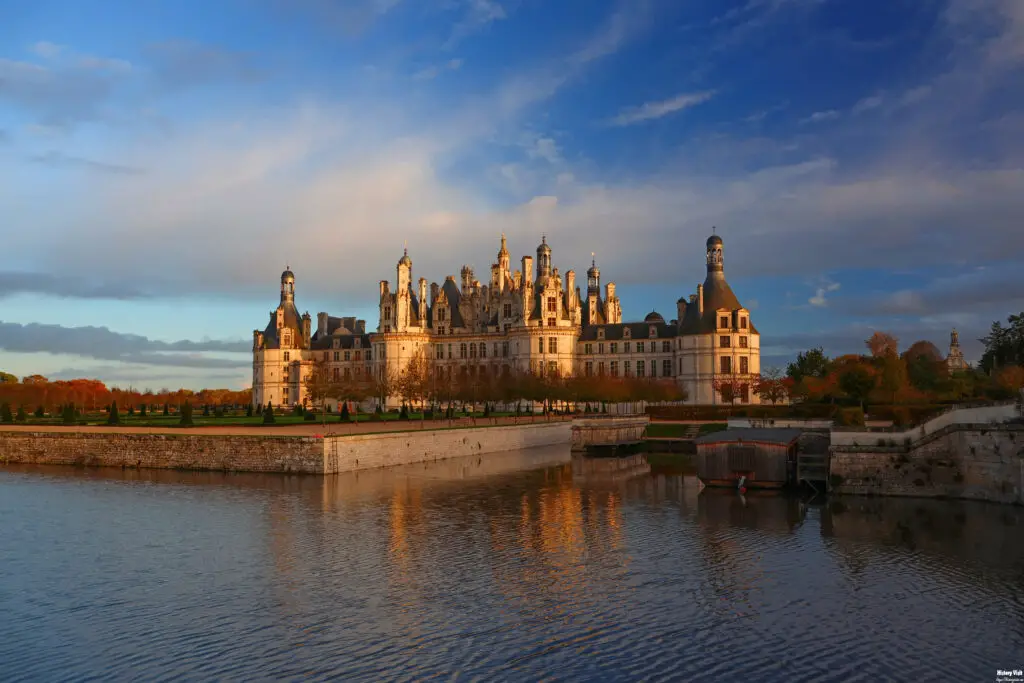
For those planning to visit Château de Chambord, practical information and tips can enhance the experience and ensure a memorable visit. The château is open to visitors year-round, with varying hours depending on the season. Guided tours are available, offering in-depth insights into the history, architecture, and significance of the château. Audio guides in multiple languages are also provided for those who prefer to explore at their own pace.
To fully appreciate the grandeur of Château de Chambord, it is recommended to allocate several hours for the visit. Starting with the exterior and the gardens, visitors can then proceed to explore the interior spaces, including the grand staircase, royal apartments, and chapel. Climbing to the rooftop is a must for panoramic views and a closer look at the architectural details.
Comfortable footwear is advised, as exploring the château involves considerable walking, both within the building and in the surrounding grounds. Photography is allowed in most areas, but visitors are encouraged to be respectful of the historical and cultural significance of the site. The château also offers several amenities, including a café, a gift shop, and picnic areas, ensuring a comfortable and enjoyable visit.
Conclusion
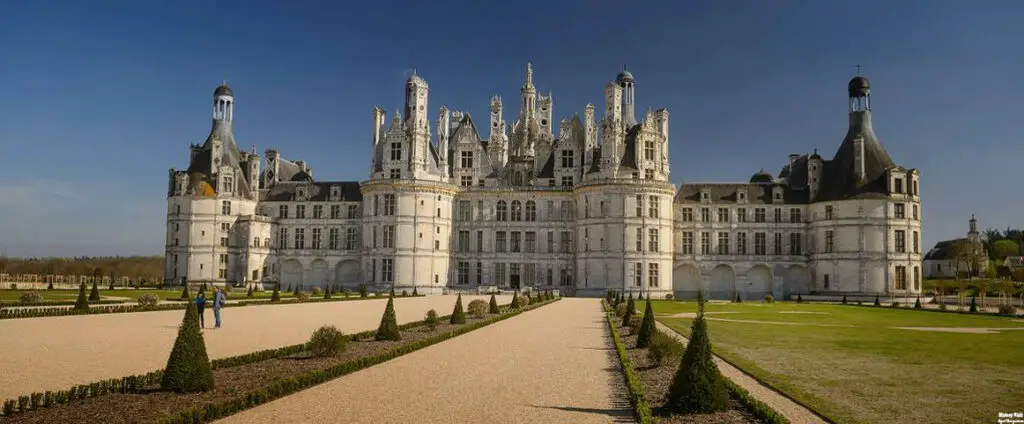
Château de Chambord stands as a magnificent testament to the opulence and grandeur of the French Renaissance. Its intricate architectural design, rich historical significance, and breathtaking natural setting make it one of the most iconic and visited châteaux in France. From its stunning exterior and the ingenious double-helix staircase to the luxurious interior spaces and panoramic rooftop views, Château de Chambord offers a unique and enriching experience for visitors.
The château’s enduring legacy is reflected in its ongoing preservation efforts and the countless visitors it attracts each year. As a UNESCO World Heritage site, Château de Chambord is not just a relic of the past but a living monument that continues to inspire awe and admiration. Its blend of architectural beauty, historical significance, and natural charm makes it a must-visit destination for anyone exploring the Loire Valley.
As you explore Château de Chambord, you are walking through centuries of history, art, and culture. It is a place where the past and present converge, offering a profound and enriching experience that leaves a lasting impression on all who visit. Whether you come for its historical significance, architectural splendor, or serene surroundings, Château de Chambord remains a timeless symbol of the Renaissance and a treasure of French heritage.


